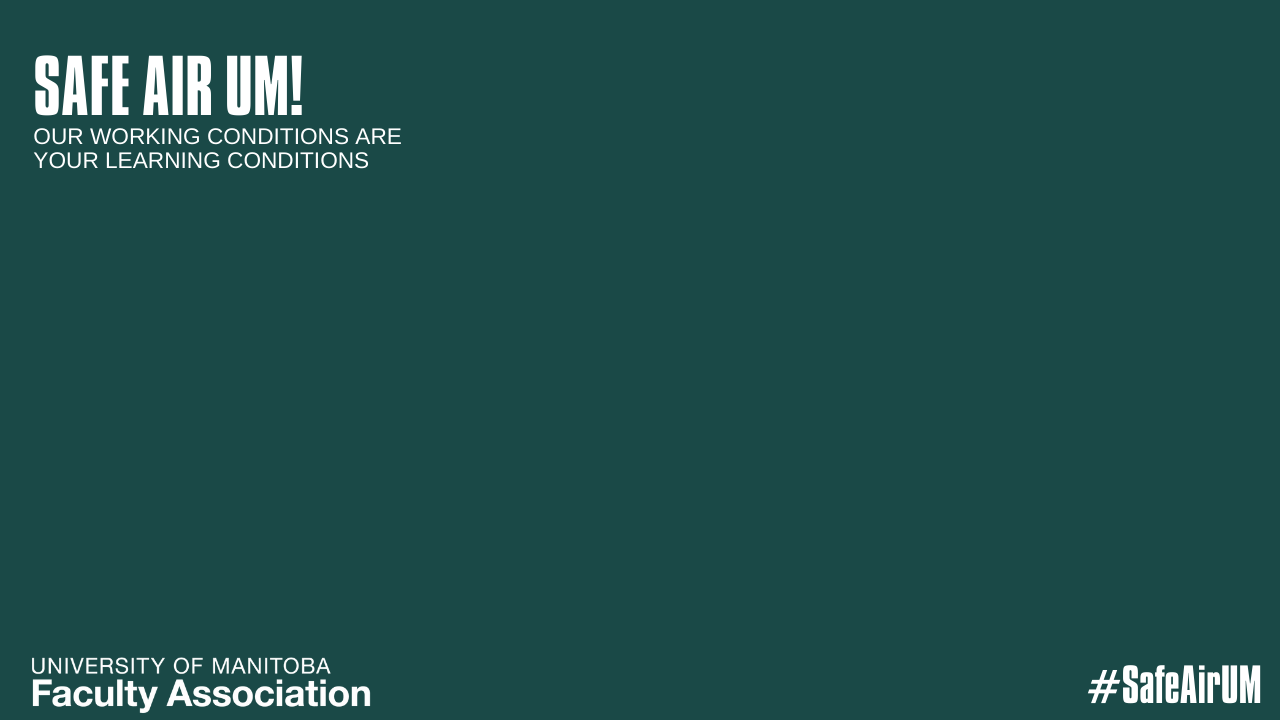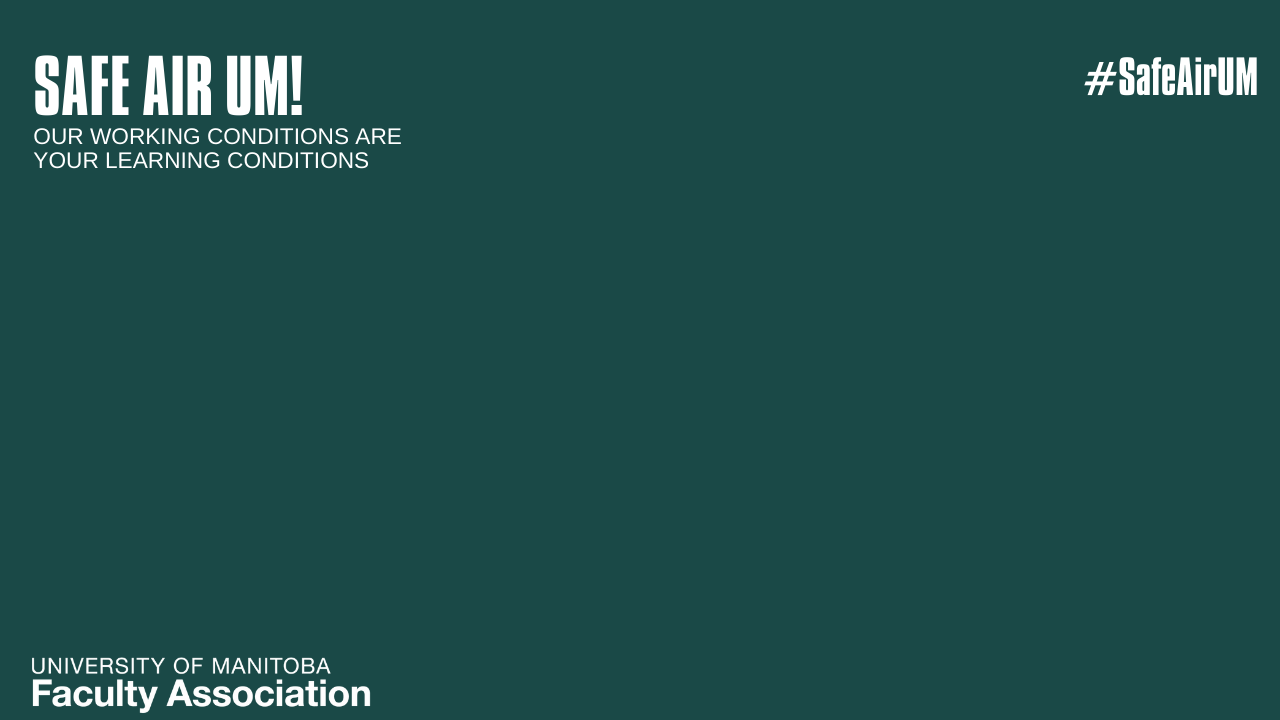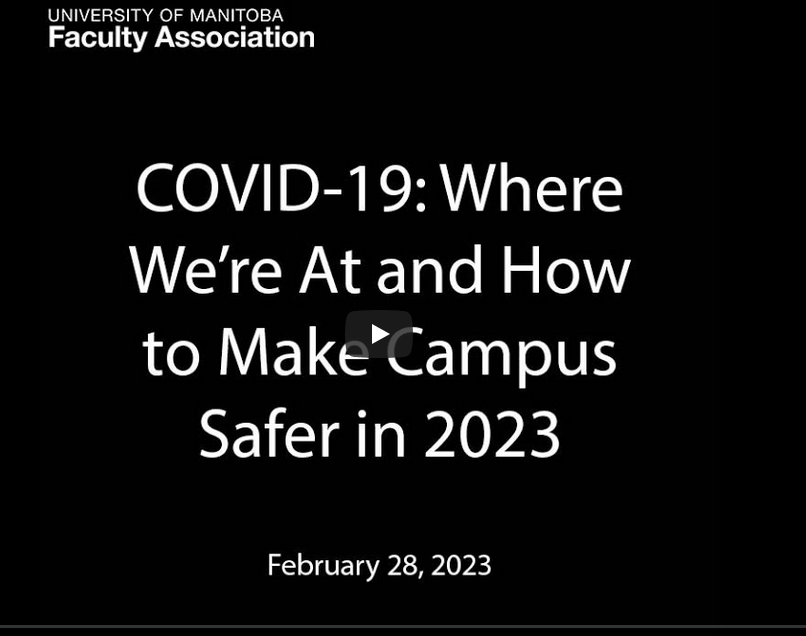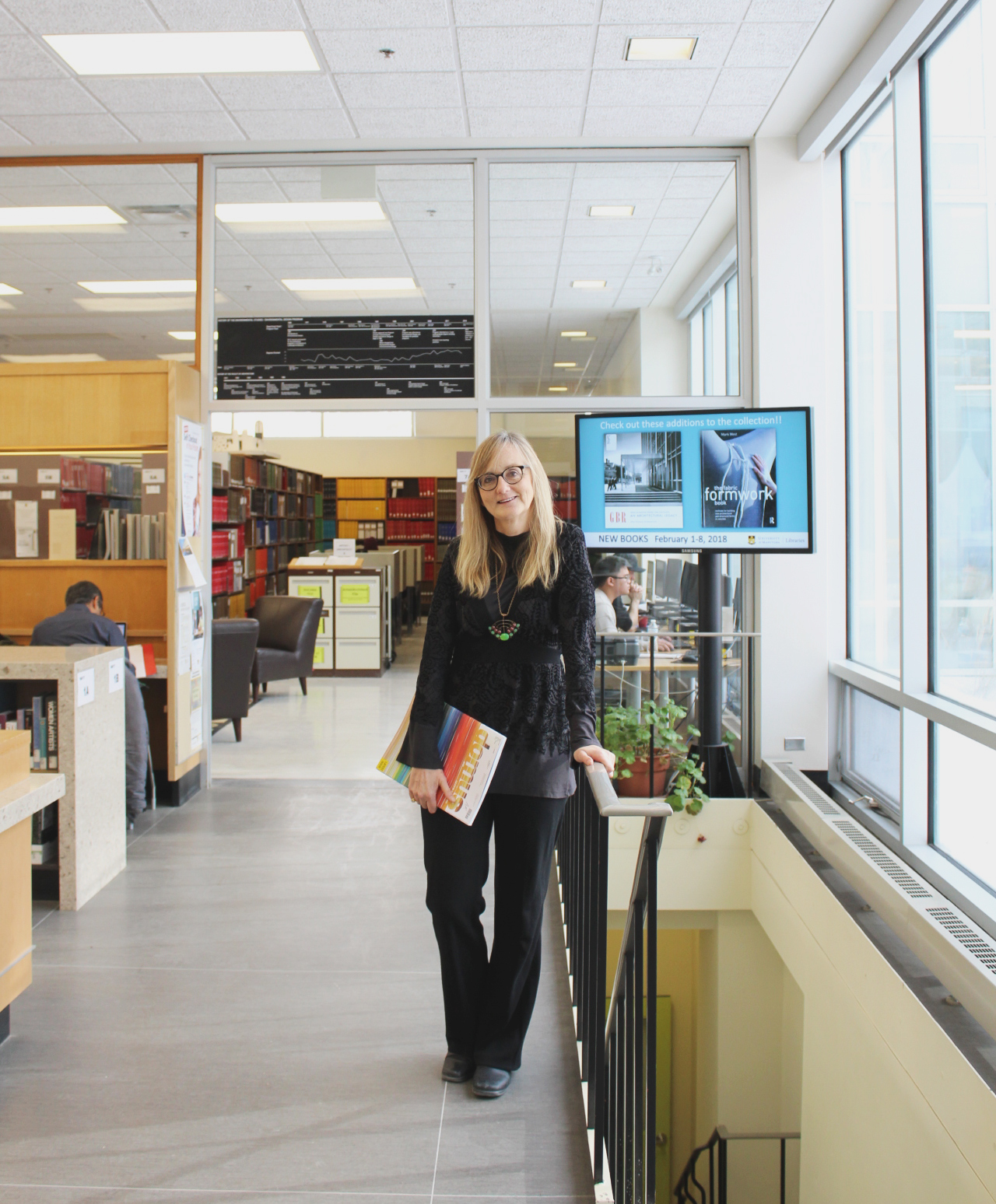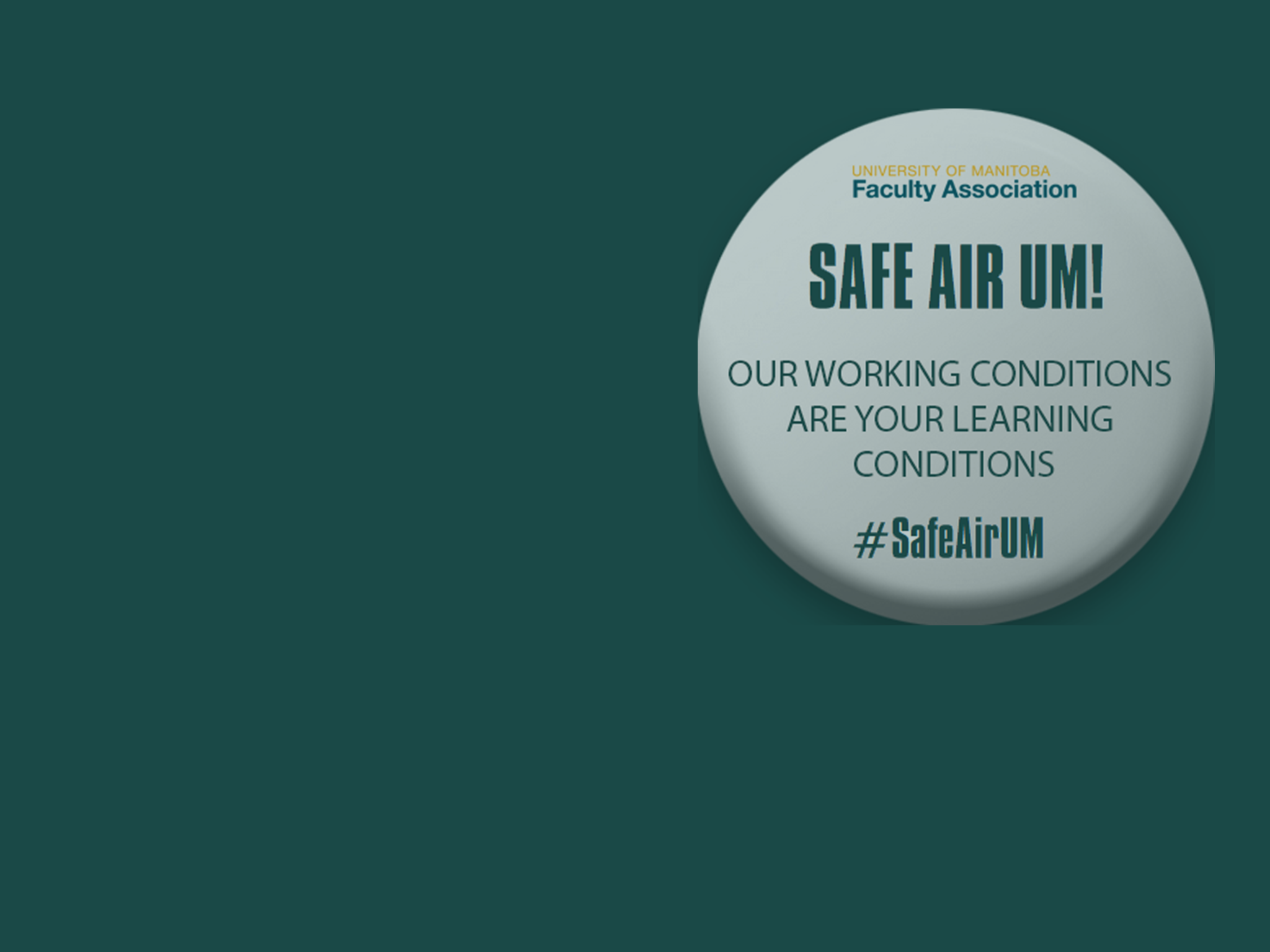
Safe Air UM Campaign
UMFA Members Organize for Safe Air on Campus
UMFA members and staff have been advocating to the university's administration to ensure a safe campus for learning and working during the continuing COVID-19 pandemic. These efforts have had moderate success. It is clear that UMFA members and supporters need to take action to get President Benarroch to ensure the University of Manitoba is a leader in ensuring safe air – a health reform for our times much as clean water and streets were for an earlier age [1]. That’s why we’re continuing the Safe Air campaign.
The pandemic is not over. We have been living with the airborne pathogen SARS-CoV-2 [2] for more than three years. Vaccine immunity wanes, and the vaccines we have do not fully prevent infection. People of all ages continue to get long COVID, a vascular disease that can cause long-term debilitating complications, such as extreme fatigue, brain fog, heart palpitations, and joint pain.
As the UM fall 2023 semester gets underway, preventing the transmission of SARS-CoV-2 and reducing community outbreaks continues to be vitally important. Effective strategies to reduce the transmission of COVID-19 include:
- Wearing properly fitted KN95 masks
- Ensuring appropriate indoor ventilation
- Being maximally vaccinated
The UM administration is obligated to take every reasonable measure to protect faculty and staff from workplace hazards, yet, these protections will not necessarily be in place as we return to campus. UM needs to be a leader and act on the basis of the best research to reduce the risk of faculty, staff, and students working and studying on our campuses becoming infected by this airborne virus. Ensuring equitable and safe working and learning conditions requires proper ventilation and continued masking. Few upgrades to ventilation and filtration have been done in UM teaching, learning, and research spaces. It is unacceptable for air quality in UM buildings to be below the standards for reducing infection that current science recommends. President Benarroch and his administration to:
- Assess ventilation and filtration in all buildings on all campuses before September 2023 to identify where upgrades are needed. Air quality must meet the American Society of Heating, Refrigerating and Air-Conditioning Engineers (ASHRAE) recently approved Standard 241, “Control of Infectious Aerosols”. The administration should create publicly accessible webpages where the locations, dates, and results of air-quality testing are reported and can be easily accessed.
- Initiate ventilation and filtration upgrades as required without delay. As interim measures, provide CO2 monitors and portable HEPA-filters (or equivalent) and implement other COVID-related maintenance as soon as possible but at minimum before September 2023.
- Enable UMFA members to mandate mask-use in the laboratories, classrooms, and office spaces over which they have direct control while performing their research, service, and teaching. Initiate a process for students who are immunocompromised, or can otherwise demonstrate a need for accommodation with respect to protection from exposure to COVID-19, to apply through Student Accessibility Services to have a mask mandate imposed on particular learning spaces.
- Renew efforts to advertise the benefits of mask use and make KN95 or equivalent masks widely available on UM campuses.
- Redouble efforts to encourage faculty, staff, and students to stay home when they experience COVID-19 or flu-like symptoms.
- Continue to have rapid antigen tests available free-of-charge for the UM community even as the federal government phases out providing them.
Extensive work on ventilation issues and upgrades needs to start right away and the UM was provided dedicated funding to start to address these needs.
Improved ventilation will not only aid in preventing the spread of SARS-CoV-2 but will also help to prevent the spread of future airborne diseases.
We are calling on President Benarroch to follow science, prioritize the safety of the university community, and prevent as may COVID-19 infections on our campuses as possible.
You can make these demands a reality.
Check out UMFA’s letter to President Benarroch as part of our continued fight for safe air. Read it here
References
[1] The Moral Imperative of Advocacy: COVID is Airborne
[2] Professor S Murthy, 2 years into the pandemic, burning questions remain about COVID-19 — and how we fight it | CBC News.
[3] Podcast: Jose-Luis Jimenez and Kimberly Prather on how public health history has influenced what we know about COVID-19 transmission and lessons for science communication (acs.org)
[4] ASHRAE Standard 241 “Control of Infectious Aerosols''
#SafeAirUM in the news
UMFA raises concerns over COVID-19 practices, published in The Manitoban July 25th, 2023
Masks and clean air can help protect our community, published in The Manitoban April 4th, 2023
Clean air is key to defeating COVID-19, published in The Winnipeg Free Press December 7th, 2022
Additional Resources
Provincial Respiratory Surveillance Report
COVID-19 wastewater surveillance dashboard
Campaign images
Click the link or the image, then right click on image and save.
Zoom background (hash tag at bottom)
Zoom background (hash tag at top)
Safe Air UM Twitter profile picture
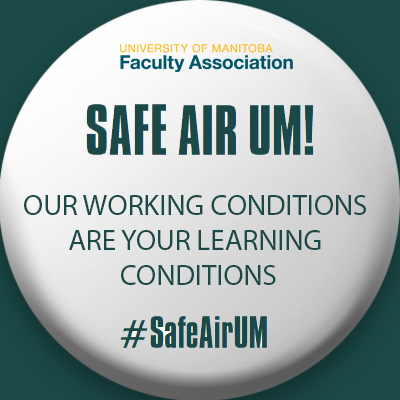
COVID-19: Where We're At and How to Make Campus Safer in 2023
If you missed the recent webinar "COVID-19: Where We're At and How to Make Campus Safer in 2023", no worries! The session is now available on UMFA's YouTube channel.
Speakers:
- Raywat Deonandan is an epidemiologist and Associate Professor, Faculty of Health Sciences, University of Ottawa
- Shauna Mallory-Hill is an expert in building design and performance and Associate Professor, Faculty of Architecture, University of Manitoba.
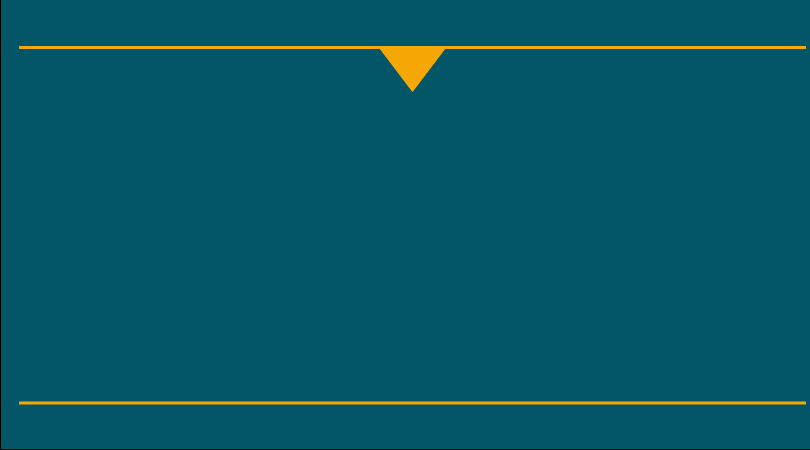
Professors and Instructors Make UofM Happen
Professors and instructors are essential to a university education. While a great portion of their time is spent with students in classrooms and laboratories, ensuring they are successful in their academic paths, much work is done outside the classroom and on personal time. Over the next few months we’ll be highlighting some of that work, as so much of it goes unseen, as well as looking at some of the common misconceptions about these professions.
We’ll be sharing individual profiles on our website and social media channels to help demonstrate the wide variety of responsibilities that these members carry out every day, thereby continuing to make UofM happen.
Profiles
Kathy Block, Instructor, Academic Learning Centre
“We teach both inside and outside the classroom.
What department and faculty/college/school do you work in?
I work as an Instructor with the Academic Learning Centre.
How did you become an Instructor at the UofM? What career path did you follow?
I have a Master’s in Education and a B.A. in Religion and English, and recently completed the Emerging Technologies for Learning Program through Extended Education. I’ve spent most of my career working with adults in academic environments. I started my career as an Instructor with the English Language Centre (ELC) at UofM and then moved into contract work with several different organizations while my kids were young.
Contract work was interesting and creative, most of all, the opportunity to work with the Centre for Indigenous Environmental Resources (CIER). I worked directly with students in an environmental program on academic reading and writing skills. CIER offered a full-time, two-year program, which was valuable and engaging for the students and a meaningful experience for me as an Instructor. The program was connected to the UofM but taught in CIER’s own space.
In 2001, I went on to work for the University of Winnipeg as the Director of the English Language Program and then came back to the University of Manitoba in 2008.
What does an average week look like for you as an Instructor at the UofM?
My work each week is varied. Mostly, I work with writing tutors. The tutors are students in the upper levels of an undergraduate degree or students working on a graduate degree and are hired and trained to help other students on their written assignments. I work directly with tutors to deliver this program. We’re now tutoring in several libraries and departments across campus. Last year, for example, the writing tutors had 4,500 appointments with undergraduate students.
I also deliver workshops in university classes that are focused on writing, and I meet one-to-one with students. On top of this, I teach a section of Arts 1110: Introduction to University to help students as they make the transition to a new learning environment.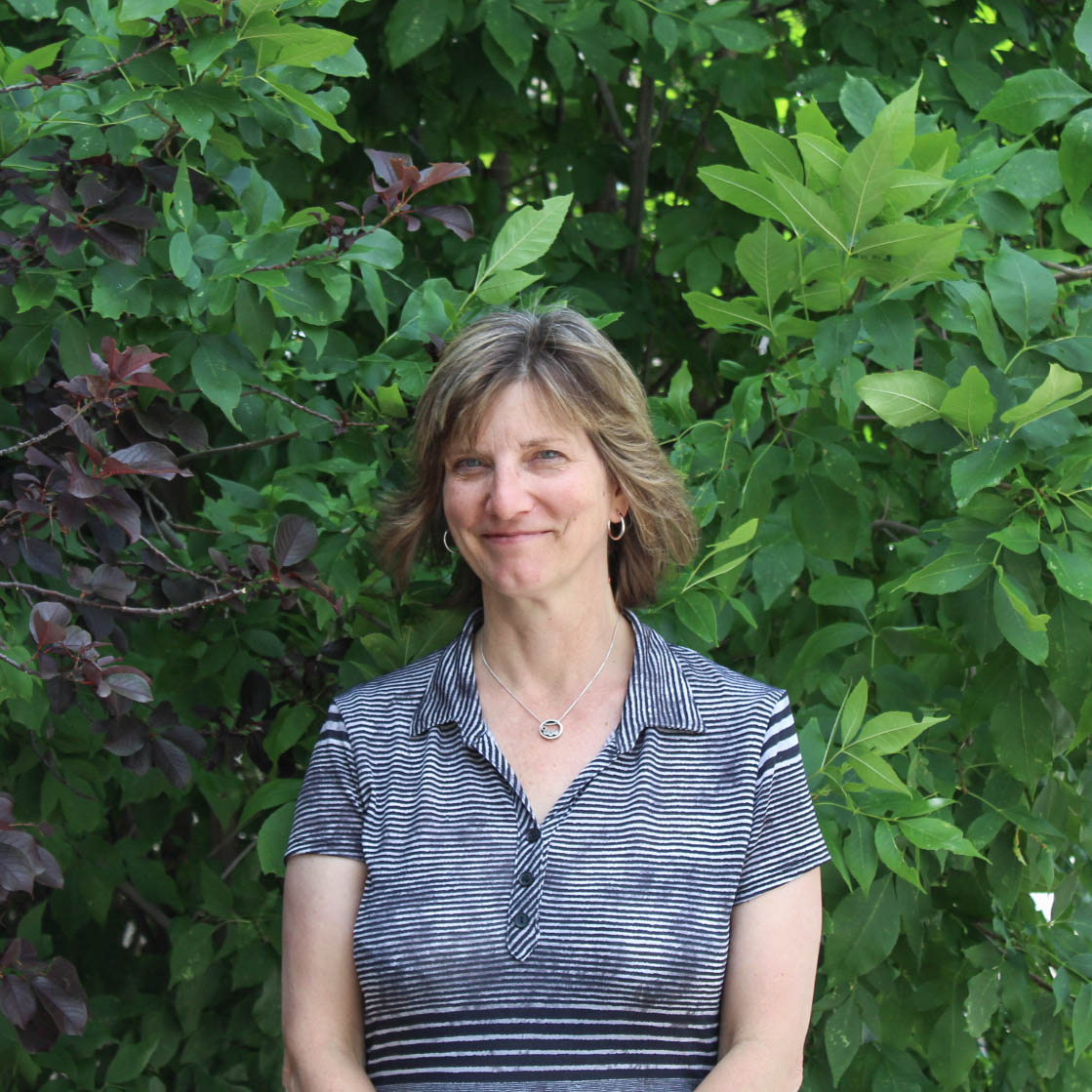
Because of the increasing cost of a university education, many students have to take on a full or part-time job during the year. Do you see the effect of this reality in your classrooms?
Since I’m running a support service for students, I see the effect of students’ busy schedules cutting into the time they have to take advantage of resources. It makes it difficult for students to access programs like the ALC’s Writing Tutor Program because students are on tight schedules. Flexibility in our programming is important.
What are your biggest daily challenges as an Instructor?
It can be a challenge to remain responsive to tutors and students while balancing other responsibilities like delivering workshops and teaching. I like to work with an open door to provide access for students.
What do you think are the most common misconceptions about Instructors on campus? What do you do in addition to teaching?
One of the big picture challenges for Instructors is that we work in many pockets and different areas on campus – it makes it hard to give a blanket statement about misconceptions.
Perhaps a misconception about Instructors is around how teaching is delivered. We consider teaching to include classroom teaching, training workshops, facilitation of one-to-one sessions, and supervision of the students we hire as tutors. It’s all teaching even though it some of it is outside the traditional classroom.
Instructors can also be seen as people who simply deliver programming, but we’re academics too. We’re highly engaged in our academic fields and we need time to reflect, read, write, and assess our work. Like other academics, we need to stand back and look at what’s working and what we need to change.
What projects are you working on right now?
I’m going on a study leave in January 2019. The focus of my leave is to understand the effect of assigning writing tutors to particular courses and how this affects classroom learning, workloads for faculty members, and pedagogy. In partnership with faculty members, we’ve accessed grants to attach tutors to particular undergraduate classes, so this research will be a follow up to that grant money. I’ll be asking questions like, “What can we do better in this initiative?” and looking at faculty perceptions of the writing support.
Why are Instructors important to university life?
Like our faculty colleagues, we are committed to excellence in teaching, learning, and putting students first. We work hard to develop partnerships between our programs and individual faculty members, departments, and faculties. These partnerships are essential to delivering services for students.
Ken Bentley, Instructor and Head Coach, Women's Volleyball
Kinesiology & Recreation Management
“I believe you come to university to find out what’s possible.”
What department and faculty/college/school do you work in?
I am the Head Coach of the Women’s Volleyball with Bison Sports, in Kinesiology and Recreation Management.
How did you become an instructor at the UofM? What career path did you follow?
I started coaching at a young age, right after graduating from high school. Our physical education teacher asked if I’d like to coach the freshman girls’ volleyball team at Murdoch McKay School in Transcona. Volleyball is my favourite sport so I said, “yeah absolutely!” It just happened to be on the girls’ side, and if they would have asked me to coach the freshmen boys’ team I would have jumped at that too. I knew nothing about coaching obviously but knew the sport well enough to give it a go.
A couple of good female friends of mine went on to play at the University of Winnipeg, so I kind of followed them there, and ended up being an assistant coach. I talked my way into a volunteer position there for 4 years which was so instrumental in my career path. Without that experience I wouldn’t be here for sure. In 1986, our men’s coach here at U of M, Garth Pischke, phoned and asked me to come in and talk about a job, which was pretty flattering because Garth is a Canadian icon in volleyball.
What does an average week look like for you as an instructor at the UofM?
An average week in season has evolved tremendously. Here’s a week from late October:
Monday I broke down film from the previous weekend for most of the day before practice, because what I see determines my plan for the upcoming week in competition. Then I trained from 4:00-6:30 and then had a Junior Bison fall camp from 6:30-8:30.
Tuesday I had two individual training sessions during the day with our athletes in between their classes and then we practiced. I finished my planning, took care of some administrative items, and then we practiced from 5:30-8:00.
Wednesday I had one individual training session. Then I was here at the office during the day, then we practiced 3:00-5:30.
On Thursday we left for Calgary to play Mount Royal University. We played Friday and Saturday. Friday morning we practiced at their facility, then we watched film right after that. Then we had the afternoon to study, rest, do whatever the athletes need, and then we played. After the match, I broke the film down for the next morning because we met again to review the film and make whatever adjustments we needed. Then we played again Saturday and flew home late Saturday night. Sunday I was here at 8:30 and I had 2 private lessons with our Junior Bison program between 9:00 and 11:00. Then I had 4 hours of fall camps after that and so I was here from about 8:30 to 3:00 on Sunday. Then Monday it starts all over again.
The Junior Bison program is a huge part of our program. If we’re playing at home, it’s not that different in that we still do our film, we still practice, it’s just that I’m not on the road, but it is pretty much the same pattern/preparation.
What is the typical class size that you teach?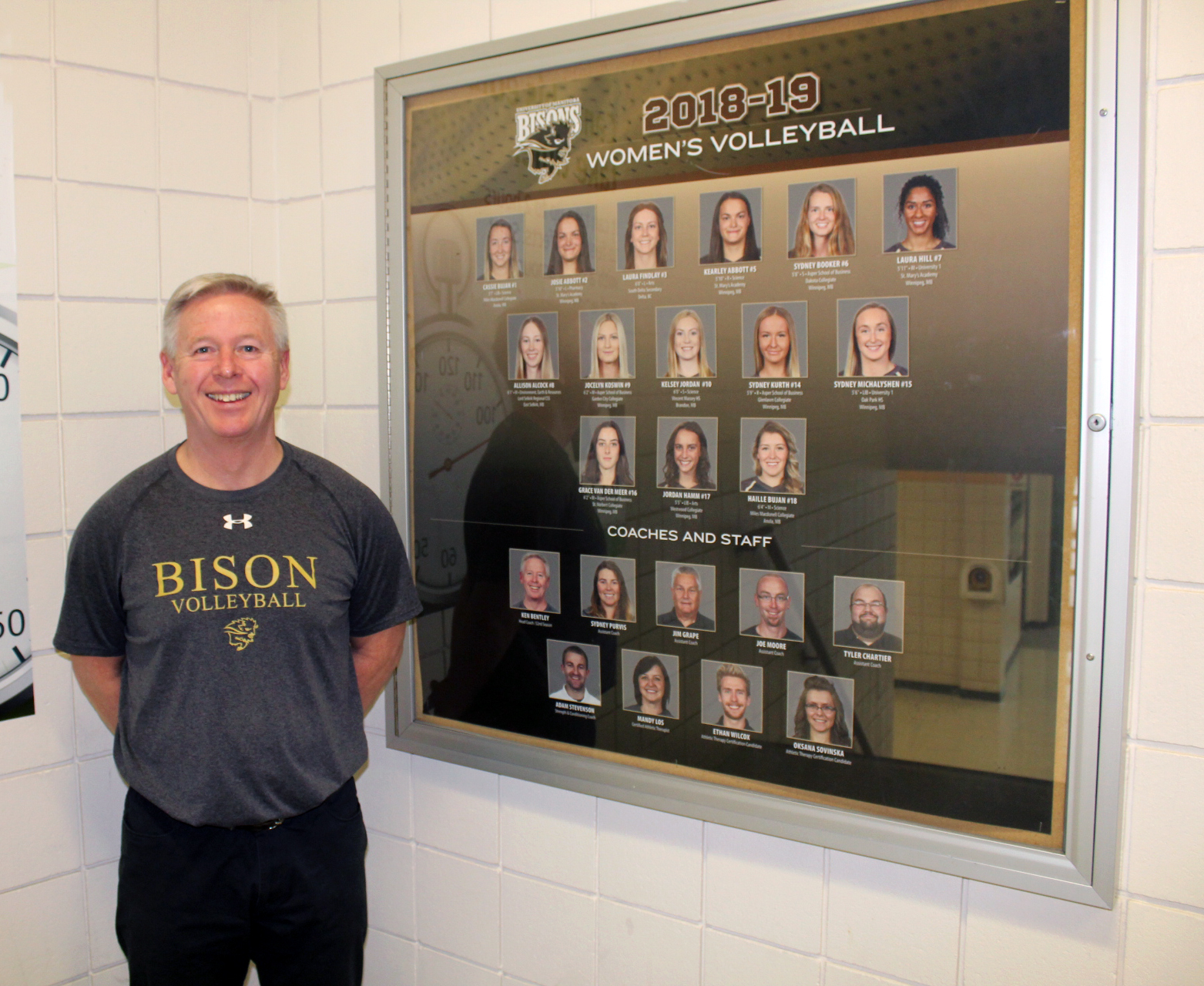
I do some teaching. The varsity team has 14 athletes but it can be anywhere from 12 to 18. I’ve also coached a club team between January and May within our Junior Bison program and that’s another group of about 10-12.
Teaching has evolved as the degree programs have evolved. I used to teach squash, racquetball, volleyball, badminton, and then those activity based courses went away, so now we focus on core sport and coaching expertise. Now I teach advanced coaching theory – the practical component. So students will choose a sport and they get both theory and practical applications in the course. I’m doing the practical component of that course and other coaches team-teach the theory part. That class is usually smaller – between 5 and 10 students.
How have growing class sizes affected your teaching experience?
It’s been the opposite for me personally. Our old activity courses used to have 30-35 students in each quarter.
The demands of our jobs as coaches has grown exponentially over the 32 years I’ve been here, so there’s way more work involved in university sport than there was. It’s just far more professional, the level has increased 10 fold in terms of athlete development coming into university sport, the overall level of university sport, the professionalism of programs across the country, which is all positive, but it leads to increased demands in every area, like generating revenue as a primary example.
Because of the increasing cost of a university education, many students have to take on a full or part-time job during the year. Do you see the effect of this reality in your classrooms?
Behind you is a large cheque for $360,000 that was donated by my great uncle, Davey Einarsson, in 2006. He is an alumni of the U of M, graduating in 1955 with a degree in geological science. He went on to a very successful career in the oil industry. His life story is quite spectacular. I presented a proposal to my great uncle with the goal of creating an endowment fund for our program, and thankfully he supported the proposal. We were able to get that amount matched through the U of M Donor Relations Dept by way of the MSBI Program for a total of $720,000.00. It is by far the most significant event in the history of our program, period. With our student athletes, there is no time to work, because we’re training upwards of 20 hours a week. It’s very rare that an athlete can work while training, on top of their academic load. I think it’s every coach’s goal to provide support to student athletes so they don’t have to worry about that issue. Obviously as costs go up, it’s more stressful for us as we have to find ways to raise more money to support the athletes as we want to, to alleviate the financial stress from them so they can represent the university in the best possible way to put their best foot forward.
What are your biggest daily challenges as an instructor?
Probably in season, getting a day off. I’ve kind of given up on it. I don’t mean that in a bad way, but honestly balance isn’t possible during the season. It’s not realistic. Just trying to carve out meaningful time for your family and for your own recovery is the biggest challenge for sure. Let’s say this weekend as an example, we have a bye-weekend, so we’re not competing, but last night I was watching a high school volleyball tournament for scouting and recruiting, then I will do that again on the weekend, then a full day of Junior Bison camp on Sunday. It’ll be a 6 hour day Sunday likely. Then, it’s 4 full weeks of competing, including travel on weekends, so there’s precious little time for much else. But that’s just the ebb and flow of the season.
Within those times I’ve got to try to find a bit of time for me, to try to keep my energy level strong, so I’ve got to maintain some level of fitness in there somewhere. It’s important for anybody, not just unique to coaching, but my activity level in practice is pretty high if I’m running drills or something, so it’s quite important for me. I would be way more stressed out if I constantly thought about balance, because it’s not possible. So if I use that as my starting point, I just ask where can I make sure I’m carving out the time to make sure I’m connected to my family and trying to maintain some sense of health in my relationships.
What do you think are the most common misconceptions about instructors on campus?
I think that they contribute far more than they’re ever given credit for, especially in teaching workload. It’s challenging because when you’re not in the professorial rank, you’re limited in terms of your advancement. But it certainly doesn’t mean you’re less dedicated or less an expert in your field.
What makes your role unique?
When we are in season, every weekend we compete, for almost 6 months, we write a pass/fail exam as a team. Either you win or you lose every weekend and then you have to absorb what you’ve learned in both cases, and then try the next weekend to be better in what you’re doing. Along the way you’re getting local, provincial, national scrutiny on how your team performs so the kind of visceral environment attached to that weekend upon weekend competition is what I think makes it unique. And no doubt there is a high degree of stress in that we are in the toughest conference in the country (Canada West), and every weekend presents a difficult opponent. We can play well and lose, and certainly if we don’t play well we are going to lose. But that is also the challenge and the excitement of what we do.
Obviously, everyone in the program, in Bison sport, is so heavily invested in what they’re doing. The highs and the lows of each weekend I think is what makes our job unique. Everyone in Bison Sport feels the sting of a weekend gone poorly while feeling elated and excited about a weekend that has gone well too. I’d say that about the whole department from our leadership down. They all play a role in the execution of our programming and they all want it to be better and I would also say we, Bison sport as a unit, is operating at a really high level of commitment and dedication to putting our best foot forward and that’s been really positive.
What’s the best part of your job?
Probably seeing a group reach its full potential. And I mean, that could take a full generation of a team; 4-5 years before that happens. When it does happen, it’s a pretty special feeling because you’ve all committed to this path, made it a priority, and sacrificed a lot of things to make that happen. Ultimately winning a national championship is a part of it, but it’s not the only part. You don’t have to win necessarily to achieve that feeling, but obviously that’s what we’re all shooting for. It’s a pretty special feeling when you have a goal, commit to it, doggedly pursue it – it’s a powerful emotion when you do succeed.
The most powerful part is the self-belief that it creates in a student athlete and that is paid forward for a lifetime. They go on and become leaders in their own right. They amplify that message out in the community in terms of being committed to a goal and seeing it through and having a little bit of persistence, knowing it’s ok to fail and it doesn’t mean the journey is over, just that you learn something along the way. To not give up but to continue to stay on the path. I think that’s just the most valuable piece of this whole thing.
What projects are you working on right now?
Our Junior Bison program has grown tremendously over the last decade, but that’s been my biggest focus outside the Varsity program. Creating year-round programming for the recreational and high performance aspirations for girls’ volleyball between 8 and 18 years old. We’re essentially offering programs year round for volleyball, so we start with mini volley. We have private lessons that go throughout the year, we have high performance summer camps for 2 weeks straight in August. We have fall camps that take place in October/November with private lessons. And then the biggest piece would be our club program which takes place between January and May. This year, we’re going to have a total of 14 teams between 13 years old and 18 years old.
Why are instructors important to university life?
Their value as teachers and what that contributes to the university is really important. I believe that this is the central role of the university. As coaches, I would say, to me, high performance sport really equates to excellence in teaching. My personal feeling is that when you’re trying to compete at the national level, you’re trying to be among the nation’s best. The commitment, the dedication to these goals run parallel to academic excellence and it elicits a high standard.
Not everyone is going to get a Ph.D., but that doesn’t mean someone can’t get a university degree and benefit from it. Many of our athletes and some of our coaches have gone onto some of the highest levels internationally, the Olympics, World Championships, etc. Garth Pischke played in two Olympics which is unbelievable, and we’ve also had alumni play or coach at the Olympic level on both the Men’s and the Women’s side. So I think these are all pretty inspirational, powerful examples of really what is possible. I believe you come to university to find out what’s possible.
Katinka Stecina, Assistant Professor
Physiology & Pathophysiology
“I came for a visit to see how spinal cord research is done in the labs – and I loved it immediately.”
What department and faculty/school/college do you work in?
I’m in the Physiology & Pathophysiology Department in the Spinal Cord Research Centre (SCRC).
What are some of the projects, research, or publications you’re working on right now?
We are one of the few labs in the world succeeding with applying designer receptors into spinal neurons. I am very excited about this project and I hope to get our publications out to the scientific community and gain valuable feedback soon.
How did you become a professor at the UofM? What career path did you follow?
I was an NCAA Division I Athlete basketball player in North Carolina, USA. My Honour’s Biology professor got me interested in neuro science and encouraged me to go to grad school. He put me in touch with the SCRC in Winnipeg and I came for a visit to see how spinal cord research is done in the labs – and I loved it immediately.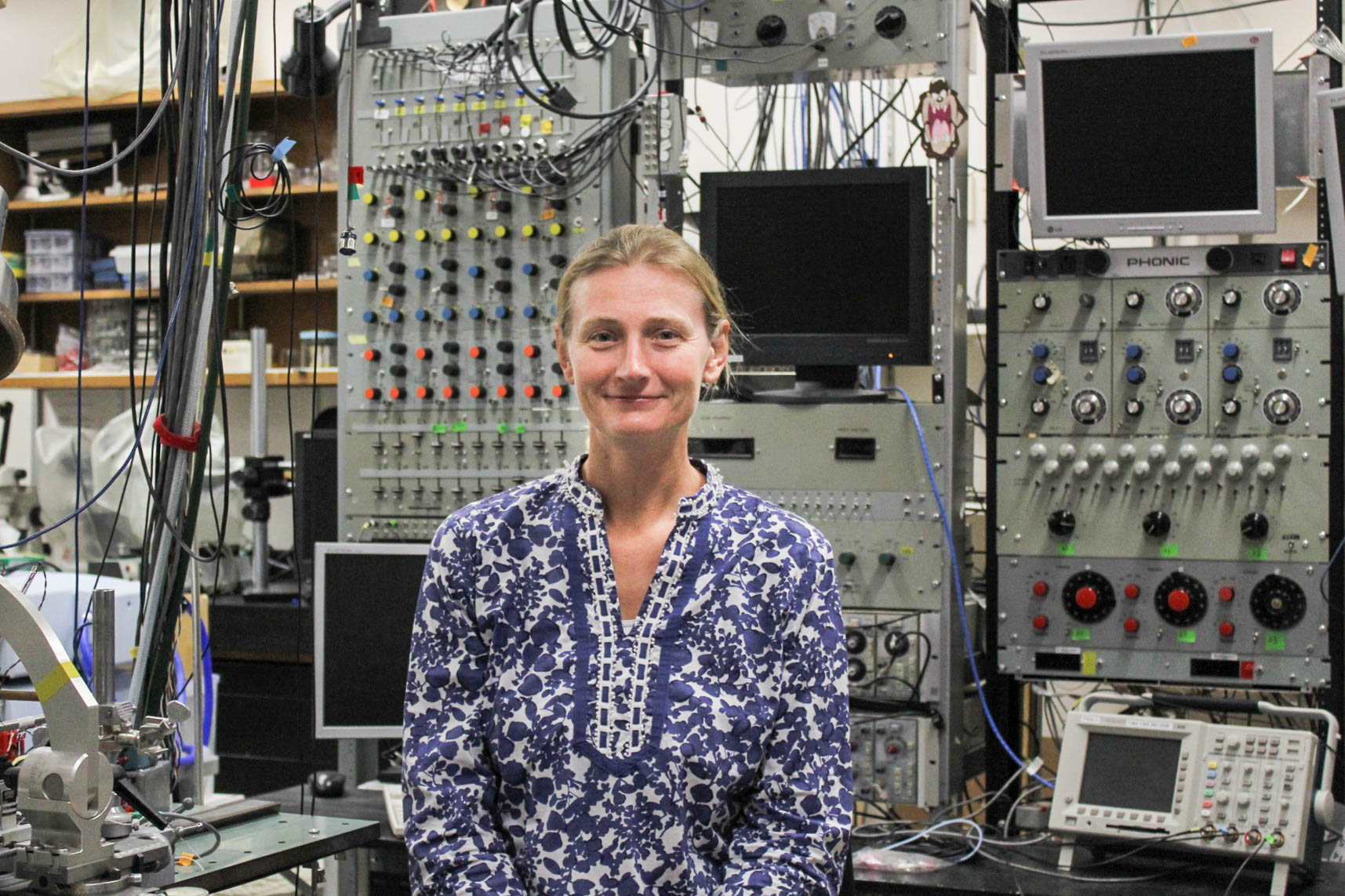
During my Master’s program, I learned more about doing research and I was able to get scholarships to continue my studies. I did my PhD at the University of Manitoba in physiology, with a specialization in life sciences. My research was focused on spinal cord and neuroscience and how spinal neurons integrate and work with each other to organize walking. The purpose of my research is to find better strategies for people recovering from injuries like stroke or spinal cord injury.
What are your biggest daily challenges as a professor?
It can be hard to balance long hours in the lab with my responsibilities for my family and children. It’s always tricky trying to fit everything in, from homework to their after-school work activities and all other “family things” and at the same time, keep publishing results from the lab.
Because of the increasing cost of a university education, many students have to take on a full or part-time job during the year. Do you see the effect of this reality in your classrooms?
Yes, I’ve always noticed this – although, these days it is more like “a must”. This can actually have positive effects too – some of my students who are committed to work in addition to school tend to be much more organized and better prepared than others without the extra responsibilities.
I tell my students to keep their part time job to help them stay on top of things. It’s really difficult to get grants, scholarships, and funding. I’ve noticed - it’s especially bad for international students. I think it’s really important that the Naylor Report suggestions are taken for the sake of grad student training.
A new summer student recently told me that she made more money waiting tables than going to grad school – it’s hard to make that sacrifice and choose further studies when the funding isn’t there to support students. We need to make it more secure, accessible, and attractive to continue to do research.
What makes your role unique in your department or faculty?
Each lab in our Department is a unique “island” of its own. This is because our research varies so widely. Yet, we depend on each other for collegial support and feedback as well as for sharing resources efficiently. So, I do not really consider myself more unique in our Department than any of the other labs.
Many people assume professors take the summer off, is this true?
I wish it was true! The dynamics of our work changes in the summer, and I always try to commit more balanced time for “family” and “work” programs, while in the winter the work programs take up the majority of my time.
What’s the best part of your job?
The interactions with students, colleagues, and such a wide range of people in all areas: location, knowledge base, interest, cultural backgrounds etc. I love learning from others and discovering more about the “details” – little things in life that can help us to be more considerate, efficient, and aware of how we perform different tasks, our research, and teaching.
I also love being able to test an idea using the right tools. Asking questions like, “Can we develop another treatment method?” or “Can we develop another, better way of testing things with human subjects?” I see a whole world of opportunity to use the equipment we have access to and try new things.
Are you involved with communities outside of the UofM as part of your academic work? If yes, why is public engagement important?
I am an active volunteer at my children’s school, coaching sports, and participating in outreach programs through the university. I do outreach with the neuro science network in Manitoba. For example, I help with the high school neuro science competitions. These engagements are important so that our society will be open to working with each other and learn how to better help each other in daily life.
Derek Krepski, Assistant Professor
Mathematics
“I’m always looking for patterns within a defect of a pattern.”
What department and faculty/school/college do you work in?
I work in the Department of Mathematics in the Faculty of Science.
What are some of the projects you’re working on right now?
I’m currently focused on research in an area of geometry or algebra that some people call higher structure, or higher categories. The “higher” here means more hidden. Mathematics is all about structure and trying to understand rules and patterns. Occasionally, you come across something that you thought followed a certain pattern and you have to discover how far off it is from the pattern you thought it was going to follow. I’m always looking for patterns within a defect of a pattern. This theme is something I’m gravitating towards in a couple of projects I’m working on right now. It’s all about adjusting perspectives in order to move forward.
How did you become a professor at the UofM? What career path did you follow?
I got my PhD at the University of Toronto and from there I did two post-doctoral fellowships, one at McMaster University and the other at Western University – I left halfway through that second post-doc because I was offered a job at the UofM.
My area of study and research has been in geometry – more specifically, symplectic differential geometry which is a mix of algebra and calculus.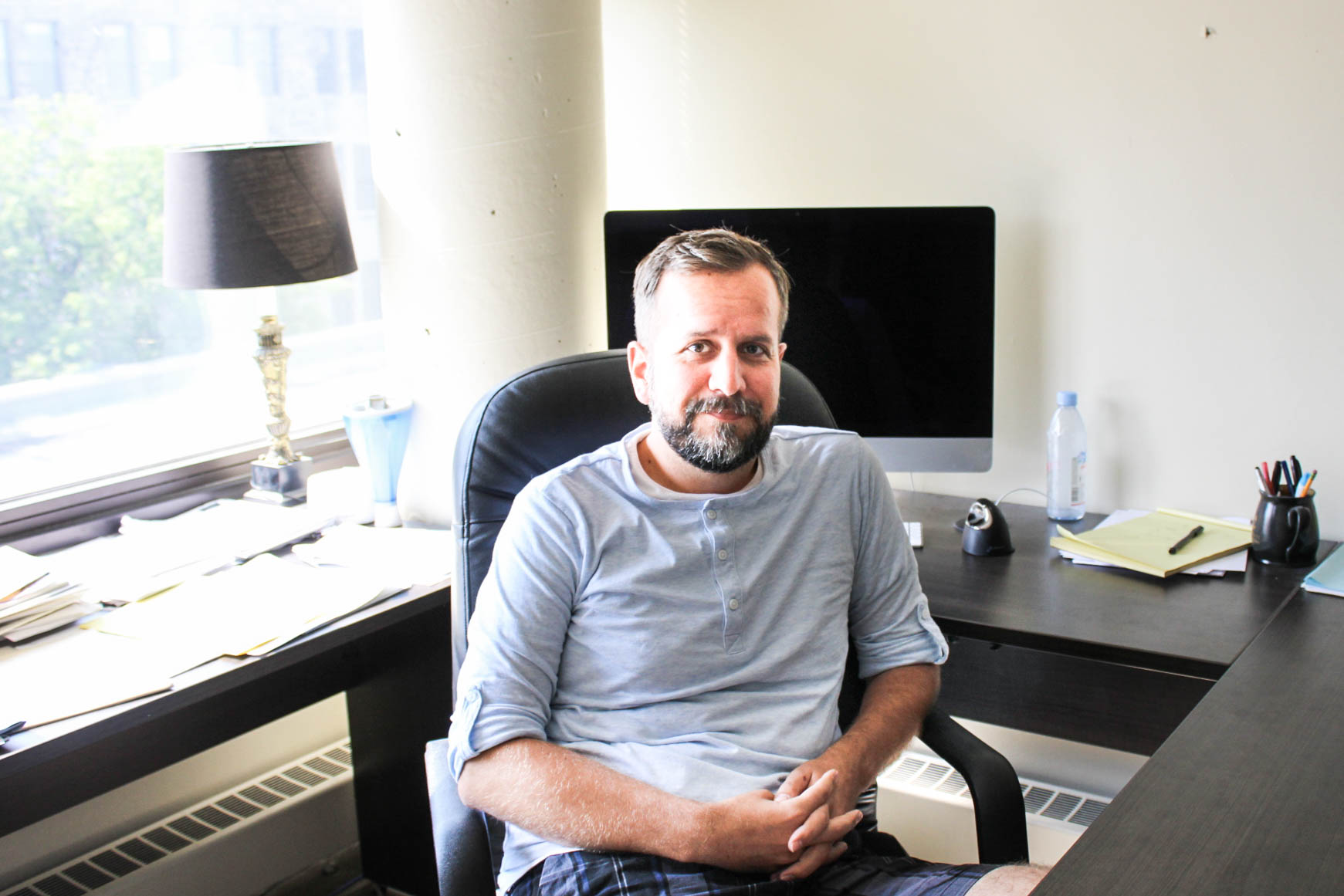
What does an average week look like for you as a professor at the UofM?
I don’t really have an average week. Each term feels different. During the fall and winter terms, I’m focused more on teaching. I usually teach one large service course (like first year calculus) which can be very time intensive because of how many students are in each class, usually upwards of 100. I spend a lot of time helping students over email. The rest of my week is usually filled with meetings for committees, and any time I have left over is used for research.
What are your biggest daily challenges as a professor?
I feel lucky that I get to do something I’m passionate about every day and things are generally positive. My biggest challenge is managing time. I feel like I’m half teacher and half researcher. Sometimes the two mix, which is great. But sometimes they don’t. I don’t want to say no to students or meetings, but a challenge to then fit in research.
Because of the increasing cost of a university education, many students have to take on a full or part-time job during the year. Do you see the effect of this reality in your classrooms?
Yes, definitely. On the one hand – it can be an issue if students can’t make lectures because of work commitments. I really want students to come to class and participate, ask questions, and get the most out of their educational experience. On the other hand, I understand if a student needs a job in order to get an educational experience in the first place. It’s unfortunate that this can have negative impacts on their learning experiences.
Are you involved with communities outside of the UofM as part of your academic work? If yes, why is public engagement important?
My research is theoretical in nature – there’s not always a particular application in mind. Although I’m studying these theories and concepts for their own sake, someone could always pick up one of these ideas and find a way for it to benefit humanity directly sometime in the future.
I think it’s generally important for everyone in the department, and mathematicians in particular, to take opportunities and show people that math is great and it’s not scary. Sometimes I get to do a guest lecture, or run math contests to get kids in K-12 system excited about doing math. Math can be fun, as corny as it sounds.
What do you think are the most common misconceptions about professors on campus?
When I say I’m a mathematician, I tend to hear a lot about people’s insecurities related to math. There seems to be a prevalent and common distaste for math. I try to communicate that mathematics can be creative as you’re trying to work through thoughts and ideas in order to place them in a certain framework. But it can be hard to describe exactly what my research in geometry looks like since it’s more on the theoretical side, done through reading, pen, and paper, and writing things out on a whiteboard.
What’s the best part of your job?
The best part of my job is that I get to keep learning. In a broad sense, I continue to do that same things and teach similar topics, but because of the research element, I get to live the student experience forever. I’m always looking in textbooks and journals and discovering new research and other people’s unique ideas. I love that I get to maintain an attitude of lifelong learning. It’s exactly the experience I want my kids to have – to be lifelong learners.
In some definition of the phrase, I’m “making it” as a mathematician, but that doesn’t mean I still don’t find it hard. I read papers or textbooks and I’m always trying to learn something new but it still feels difficult at times. Sometimes it’s frustrating but it’s also so satisfying when an idea or concept finally clicks. I love that my job allows me to experience that feeling.
Emily McKinnon, Instructor
Access and Aboriginal Focus Programs
What department and faculty/college/school do you work in?
I work in the Division of Extended Education, in the Access and Aboriginal Focus Programs.
What projects are you working on right now?
I’m focused on increasing the success of Access students in science and math at the university level. Our program has ~180 students, representing students in many faculties and degree programs. About 85% of our students are Indigenous, the rest are newcomers, northern residents, and low-income students. One of the unique and most beneficial things the Access Program offers is that we teach our own first year courses. For example, I teach first year biology in a special, small section, offered only to our students – the regular sections of the same course have over 200 students per class and my classes are usually less than 20. I am also responsible for supporting our students in math and other science courses, by organizing tutors (free for Access students), study sessions, extra workshops, and connecting them with resources on campus.
How did you become an instructor at the UofM? What career path did you follow?
I studied migratory songbird ecology during my PhD at York University and continued that research in my post-doctoral fellowship at University of Windsor. I taught courses as a sessional instructor in biology at the University of Winnipeg and University of Manitoba during my postdoc.
My role with the Access program is my first move to a position focussed primarily on teaching. The Access program is designed to support students facing barriers and help them succeed in academia. I work closely with personal counselors, Indigenous elders, and academic advisors to give students holistic support throughout their university experience.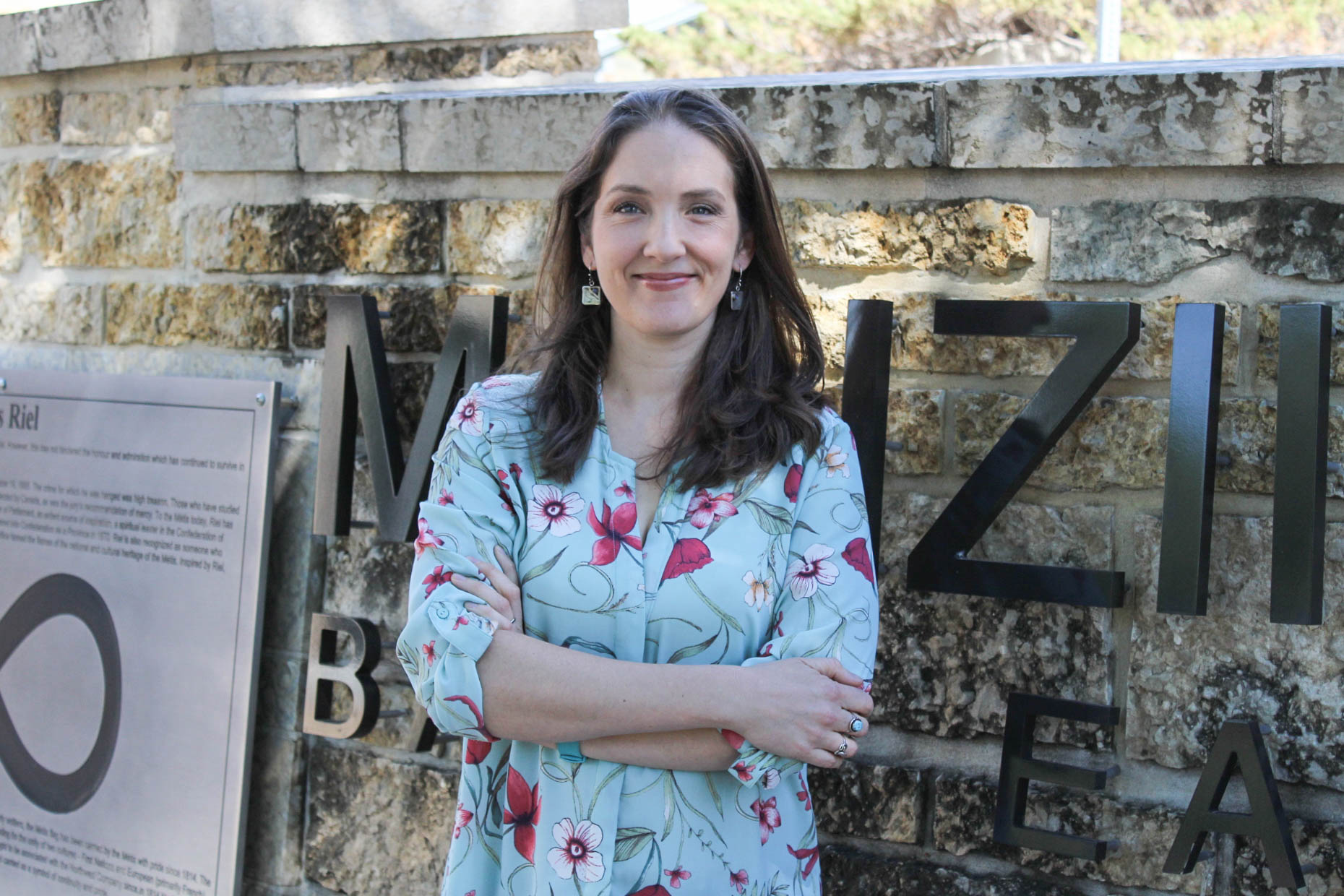
What does an average week look like for you as an instructor at the UofM?
I spend most of my time teaching and working directly with students. Access Program is located at Migizii Agamik so I get the chance to attend ceremonies with our grandfather-in-residence Wanbdi Wakita, and other cultural events, and learn about various ways to support our students in a culturally sensitive way. I also run workshops every week to give our students extra learning opportunities related math and science courses.
Because of the increasing cost of a university education, many students have to take on a full or part-time job during the year. Do you see the effect of this reality in your classrooms?
Most of our students get student aid or band funding. But this is usually just a drop in the bucket. Many of them still need to get jobs to support themselves and often their dependants. By the time they get to their second year, it’s almost a guarantee that they have to work as well as attend classes.
The provincial government just recently cut all of the Access bursaries (some students in Access previously got a non-repayable bursary to top up their student loans; for the first time, this is no longer available to our students). If you have to get a job as well as keep up with school work, then you’re distracted from studying and it inevitably impacts your grades. It makes it harder for students to get into highly competitive professional degree programs like medicine. It means we aren’t feeding these students into the pipeline for professional health careers and the end result is a diversity and inclusivity problem.
If students aren’t taking advantage of all opportunities available, it’s because they’re working, paying for daycare, or helping care for extended family.
What do you think are the most common misconceptions about instructors on campus? What do you do in addition to teaching?
People assume I do research. And people always think I have summers off. I’m actually really busy in the summer. I run summer camps for northern students during the summer, a math prep camp for Indigenous students, and we do extensive orientation for incoming Access Program students. In the Access program we also interview every new student we take into the program. There’s always lots going on!
What makes your role unique?
There aren’t a lot of full-time instructors in Extended Ed compared to a traditional faculty like Science or Arts. Furthermore, in Access, instructors have a really unique role because of the holistic way we approach things. We work as a team to provide a strong emotional, spiritual, physical, and academic supports for our students. It’s really a model system that would benefit so many students.
Why are instructors important to university life?
We’re teachers that interact with students on a daily basis. We allow professors to focus on their research while we provide the backbone by teaching many intro and core courses. In first year especially, this is where we can help students get on their feet. We want to set them up well for their whole degree, so they can excel in upper year courses, and work on their own research with professors in their senior years. They wouldn’t make it to the honours level without the great instructors teaching them along the way!

ULP Update | May 11, 2018
University of Manitoba agrees to apologize, pay maximum fine as per Labour Board ruling on Unfair Labour Practice
As you know, in January the Manitoba Labour Board found that the administration committed an Unfair Labour Practice during our 2016 round of bargaining. We recently asked President Barnard to apologize, and pay the maximum amount of damages ordered by the Labour Board as a way to help heal some wounds that the ULP created.
I am very pleased to announce that the Administration has decided to pay the maximum fine and issue an apology to the Association and all of you as directed by the Labour Board.
In secret talks with the University administration, the Pallister government imposed a one year deal with a 0% salary increase. At the direction of government, the administration kept this information from us for weeks, revealing it only a few days before the strike deadline.
Agreeing to pay the maximum fine of $2,000 per member and $2,000 to UMFA is a positive step in helping us move forward in rebuilding our relationship with administration.
In terms of concrete steps, we believe the administration will be paying out the fines as soon as possible. Each member will receive the $2,000 whether they participated in strike action or not. It is to the understanding of both the administration and UMFA that damages are not compensation and thus are not taxable. However, they will be looking into this, if it turns out that the amounts are taxable, the relevant deductions will come from a future pay period as required. We will keep you informed about this information as it becomes available.
Janet Morrill
UMFA President
ULP Update | April 19, 2018
Hello everyone,
We’re pleased to let you know that the Manitoba Labour Board has today upheld its finding that the Administration of the University of Manitoba violated the law during the 2016 round of collective bargaining negotiations. By following a secretive directive from the Pallister government and failing to tell the union until the last minute, the administration was found to have committed an unfair labour practice and ordered to pay up to $2.4 million in damages, as well as offer a formal apology to unionized librarians, instructors, and professors.
This reaffirms what we’ve said all along. UMFA came to the bargaining table in good faith in order to find a way to improve working conditions at the University, and that good faith was disrespected by both the University administration and the government. We’re disappointed that the administration challenged the Labour Board’s directive to apologize for what happened. For that reason alone they should be required to pay the full damages.
As per the Labour Board’s decision, UMFA intends to quickly initiate talks with the Administration regarding the extent of the fines to be paid, which amount to a maximum of $2,000 for each member of the union.
If you have further questions or are looking for more information, please contact the UMFA office: This email address is being protected from spambots. You need JavaScript enabled to view it.; or by phone 204-474-8272.
Janet Morrill
UMFA President
ULP Update | January 31, 2018
Letter from the President
Hello everyone,
I am writing to provide you with an update on our Unfair Labour Practice complaint (ULP). As you all read in our message sent January 31, the Labour Board agreed with UMFA that the administration acted in bad faith when they failed to inform us that they had received instructions from the government to freeze our salaries and only offer a one-year contract. We’re in agreement with much in the decision, but have asked the Board to clarify and possibly reconsider a few of its points.
As you also saw, the administration in their press release after the ULP decision “respectfully disagreed” with the Labour Board Decision and were “considering their options”. We were disappointed with their reaction because, at the very least, it casts doubt on the sincerity of any apology they might deliver as required by the Labour Board. The admin’s reaction also imperils future bargaining as they evidently would do the same thing again in the likely event that the government continues its bullying behind closed doors. A simple apology can go a long way in repairing relationships, and the administration has now denied that possibility.
The admin has asked the Board to review and reverse its decision. It is painful to see our employer react to the Board’s decision in this way. Even if the Labour Board retracts its criticism of the administration’s actions in the current ULP, surely it will be a pyrrhic victory if these protracted battles and protests from the administration of their “innocence” bring employee relations, and our university, back to 2016.
So, where are we now? The relationship between UMFA and the administration was at a low point in Fall 2016, and I believe both sides had been trying to move forward in small steps since then. UMFA members care about this institution and how it fulfills its academic mission. That was foremost in all our minds as we walked the picket lines. It seems like the administration’s current actions are driven by vanity, and take us two steps backwards. Although this is the third time in ten years that this administration has been found guilty of an Unfair Labour Practice, and the second time in the past year alone, the administration is still hoping to portray itself as an “employer of choice” who has done nothing wrong and bears no responsibility for the 2016 Strike. We believe this attempt will be futile: in the second-last decision against the admin, delivered merely months ago, the Labour Board noted the following:
It is hardly surprising that the Faculty Association was exasperated by the University’s continued failure to recognize its exclusive bargaining rights. The University’s actions transgress upon perhaps the most fundamental principle of labour law. It is the Board’s view that such conduct by the University must stop.
Through it all, UMFA is doing what is best for our members. Often that involves cooperation and collaboration with the administration. But if it requires that we fight, we will.
Janet Morrill
UMFA President
Check back here for more details regarding the Manitoba Labour Board decision.
For the joint press release from UMFA and the Manitoba Federation of Labour, click here.
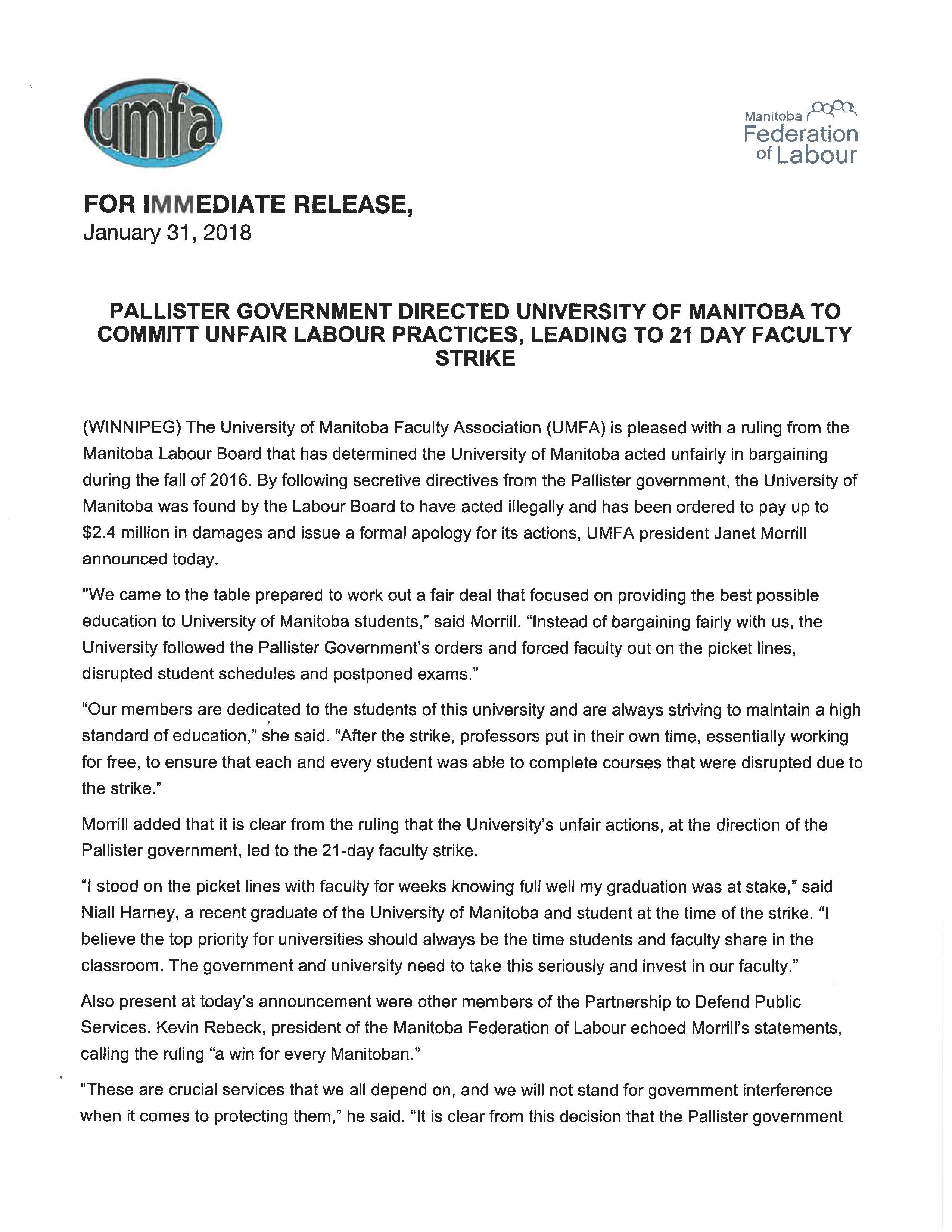
For the full ULP Decision, click here.
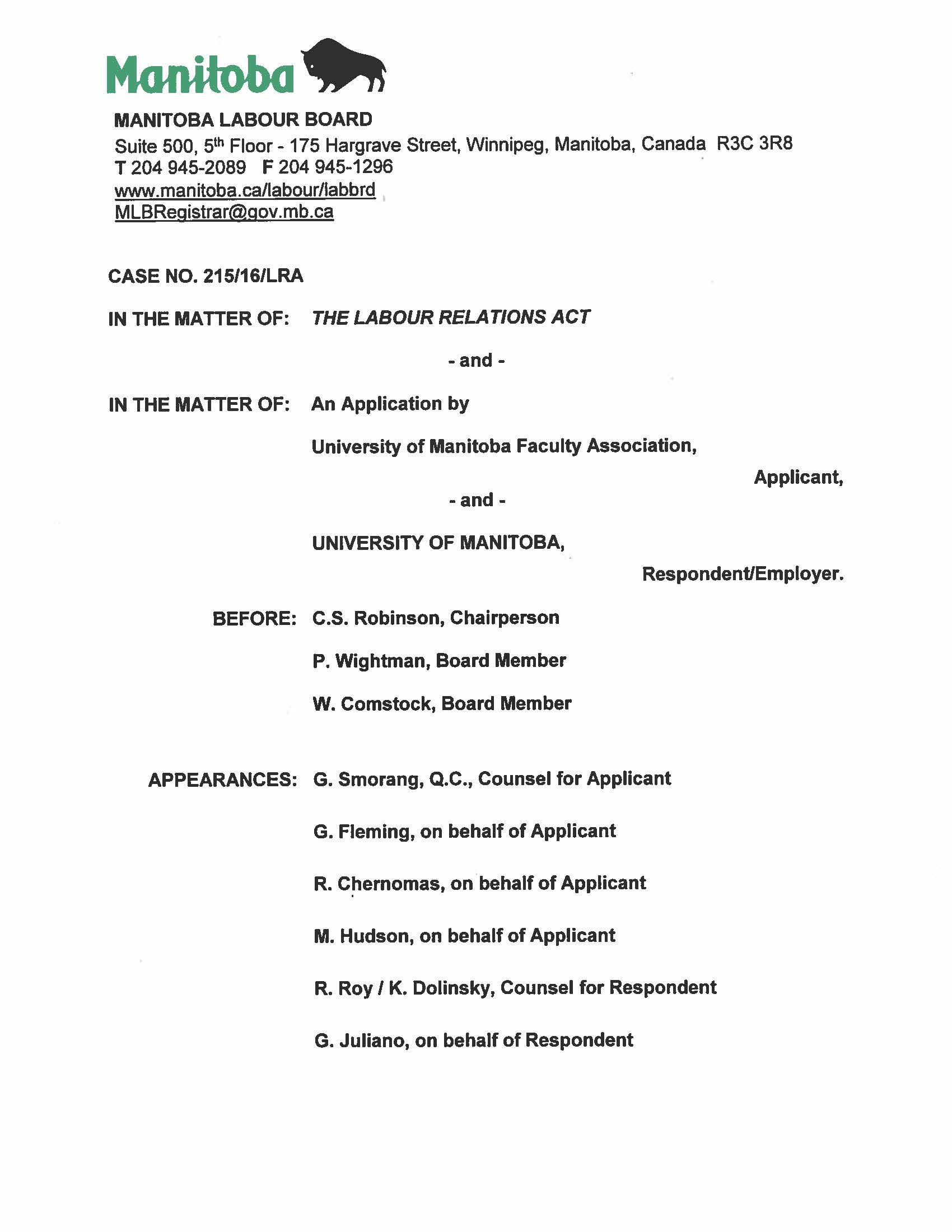
For a summary of the results, click here.
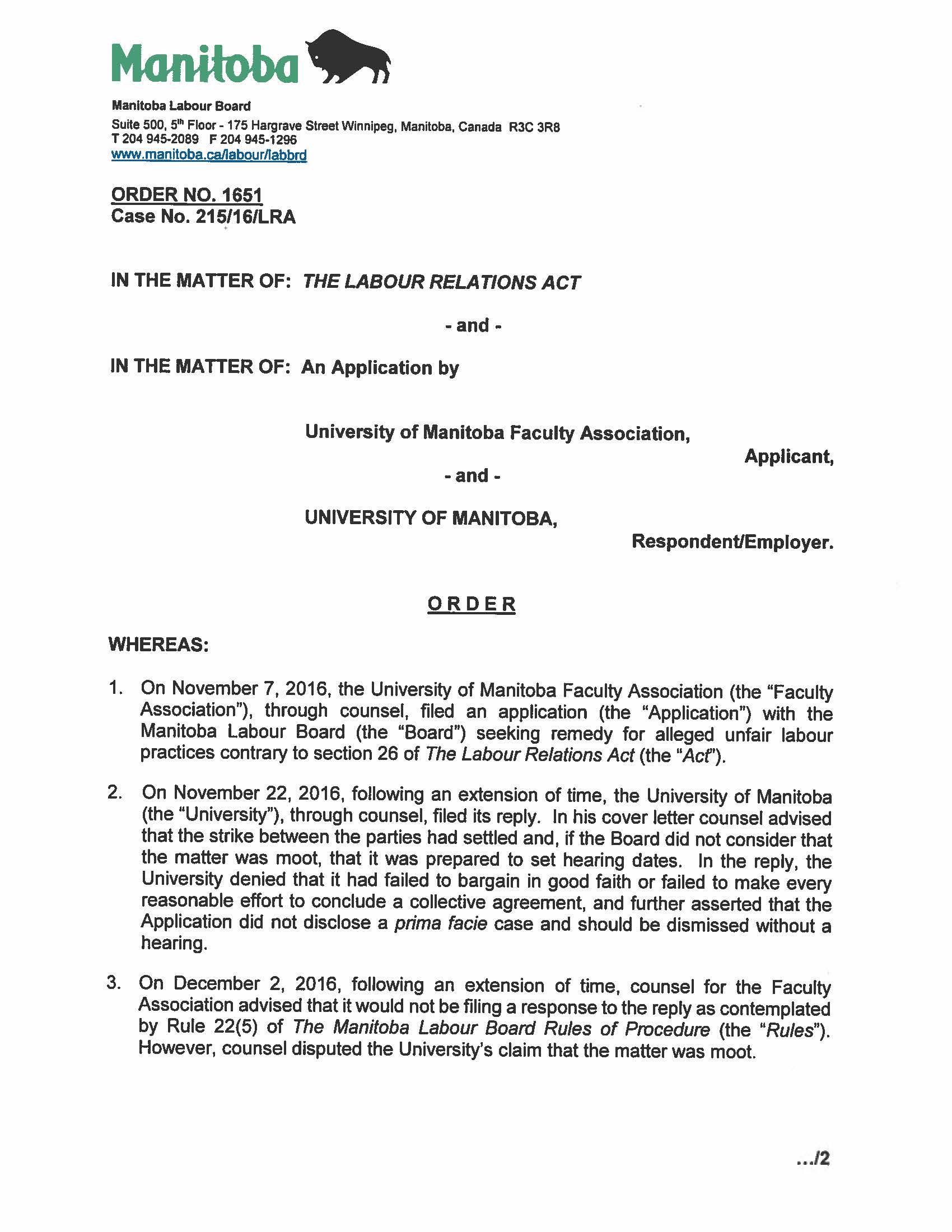
Press Coverage
Please note, some articles may not be available to view without a paid subscription to the news source.
U of Manitoba violated bargaining law during faculty strike, labour board rules
Editorial: Province's prints all over labour fiasco
Labour board finds U of M guilty of unfair labour practices
UMFA labour ruling part of bigger battle
Labour Board should enforce fine on the U of M administration
Profs Slam U of M for Labour Appeal
University of Manitoba apologizes to faculty association
U of M apologizes to faculty association, will pay labour board penalty
The University of Manitoba apologizes to UMFA members; will pay maximum remedy

To view the Report Card, click here.

Librarians Make UofM Happen
Libraries and librarians are essential to a university education. Their work spans disciplines, faculties, and departments, creating an environment for meaningful research and study. Over the next two months we’ll be highlighting some of that work, as so much of it goes unseen.
Join us in acknowledging the importance of librarians on campus as they make research and higher learning possible through their work. We’ll be sharing librarian profiles on our website and social media channels to help demonstrate the wide variety of roles and responsibilities that librarians carry out every day.
There are so many ways that we make the UofM Happen!
Librarian Profiles
Name: Orvie Dingwall
Library: Neil John Maclean Health Sciences Library
- What library do you work in? Does it serve a specific group on campus?
I work in the Neil John Maclean Health Sciences Library as the Head of Outreach Services. I provide library services to health professionals throughout Manitoba so they can stay up-to-date on current trends and use evidence to inform their practice.
- What made you decide to become a librarian?
It wasn’t something that I planned from the beginning of my post-secondary education. As soon as someone told me about the Master’s in Library Studies program, I knew it was the right profession for me.
- What does an average day look like for you as a librarian at the UofM?
It’s hard to answer that question because I don’t have an average day! Part of my day is always spent doing literature searches for health professionals, preparing for upcoming teaching sessions, and creating resources to help people be better able to incorporate evidence into their practice. I also usually having meetings as part of the different committee that I’m part of: UMFA Executive Council, my team meetings, and meetings with health professionals, students, or faculty members.
- What are your biggest daily challenges as an academic librarian?
The health professionals I liase with don’t have access to UofM Libraries electronic resources, so it can be challenging to give them access to the resources they need. In general, it’s hard to access free, high quality, evidence-based research – despite a decade of initiatives on open-access. Resource prices are skyrocketing as large publishing companies consolidate and it’s becoming a bigger issue for professors and students who need access to reliable materials. It can also be a challenge convincing people that high quality evidence is worth the time and energy spent finding and accessing it.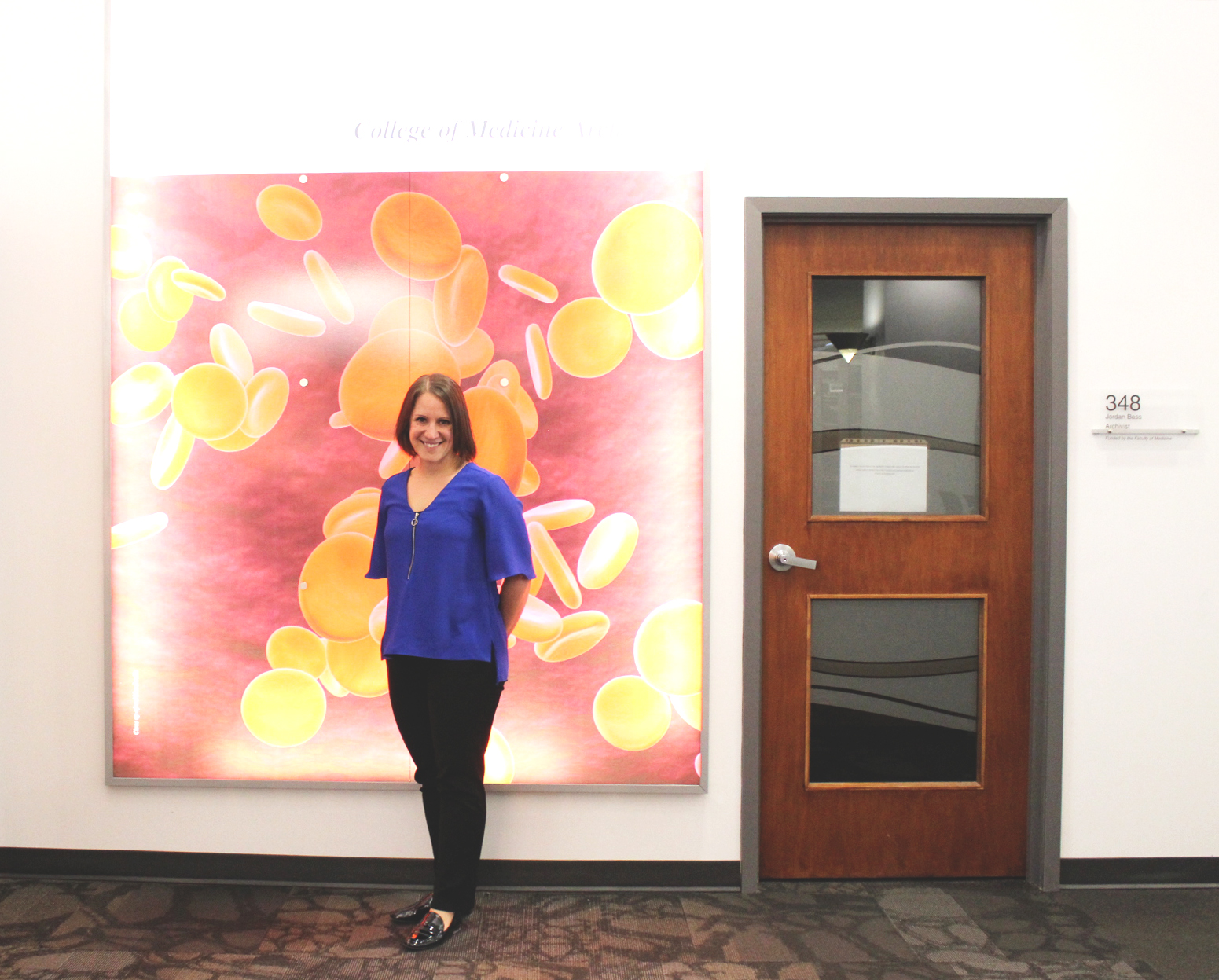
- What do you think are the most common misconceptions about librarians on campus?
That we’re all really quiet. My friends always say to me “how are YOU a librarian? You’re the loudest person I know!” So I guess the secret’s out… if anyone is getting “sssshhh’d” in a library, it’s usually the librarians!
- Why are libraries important to university life?
Information is at the heart of research and education. People are drowning in huge amounts of information but are generally starved for true knowledge and librarians can bridge that gap.
- What are some ways that students and staff on campus can make use of library services available to them?
They can make use of our electronic collections and take part in education sessions to help them learn how to better make use of all the services that our libraries have to offer. We’re always trying to find ways to be more accessible to people and we have a whole series of virtual teaching sessions where people can log in and participate online.
- The availability of online resources and electronic copies of textbooks and articles makes some people think we don’t need physical libraries or librarians anymore. What would you say to someone to convince them that this isn’t the case?
Librarians are always striving to understand what people are looking for and why. We have the ability to find what people need and show them what they’d be missing if they didn’t use library resources. If people go at it alone, they often don’t know what they’re missing from both our print and online collections.
Neil John Maclean
Health Sciences Library
727 McDermot Avenue
University of Manitoba
Phone: 204-789-3342
Email: This email address is being protected from spambots. You need JavaScript enabled to view it.
Name: Liv Valmestad
Library: Architecture and Fine Arts Library
- What library do you work in? Does it serve a specific group on campus?
I work in the Architecture and Fine Arts Library. I serve the Faculty of Architecture which includes undergraduate students in environmental design and graduate students in landscape architecture, interior design, architecture, and city planning. I also serve the School of Art, both undergraduates and grad students in art history and studio classes. Our university is one of the few to have a dedicated library for fine arts and architecture and – we have a very large, comprehensive and prestigious collection.
- What made you decide to become a librarian?
I never planned to become a librarian, I sort of fell into it! After studying visual art at the University of Saskatchewan and also in Norway, I was finishing my art history master’s at Queens and was offered a position as a library technician in the art library there. I took it and worked at the reference desk. From there, I did my master’s in library science and I was able to use my subject expertise and multiple graduate degrees to be hired in the Architecture/Fine Arts Library, here at the U of M.
- What does an average day look like for you as a librarian at the UofM?
I meet with a lot of students. For example I was just helping a design student working on a project about millennial workspaces. I also guest lecture in classrooms and do workshops on how to research specific topics. I also teach a class on visual literacy/culture to first year environmental design students, which allows me to use my background in art history, design, fine arts, and research.
I’m on a university-wide committee for visual plagiarism and will be helping to create the online modules.
I answer student and faculty questions all the time and I actually worked at the reference desk in this library for 20+ years.
I spend time answering emails from designers, artists, architects from around the world.
I’m currently working on an application for an endowment fund to get the money we need for a video streaming service so students can access videos of interviews with architects, art films, performance art, etc.
These are just some of the things I do on a daily basis!
- What are your biggest daily challenges as an academic librarian?
My work ebbs and flows, there’s no predicting the work level at any time! It’s a challenge because we could always use more staff. We’re constantly busy because students and faculty are used to an excellent level of service and we try our best to maintain that level with not enough staff. We really pride ourselves on student engagement and interactions where we can actually learn what they’re researching or studying. This informs what resources we point them to and what research materials we order and the classes that we teach. Basically, we’re trying to provide high quality, personal service even with budget cuts. We also have a bit of a space issue and we often have to pull collections from our shelves to make room for new material.
- What do you think are the most common misconceptions about librarians on campus?
We teach, research different subject areas, publish, apply for grants, do service work, and participate on international committees. I’m also a visual artist so I get to work on my paintings during my sabbaticals and interesting projects like documenting the outdoor sculptures on campus. I recently project-managed the re-furbishment of the Expo ‘67sculpture outside of Fletcher Argue through a Manitoba Heritage Grant.
- Why are libraries important to university life?
Libraries are a teaching lab and a learning space where students can do hands on research. Most of our materials are print (unlike some other libraries). We’re largely image based and it is expensive to get the copyright to reproduce these materials digitally. But the benefit of this is that students get to be hands on with our material. They can look at a book as an artifact. Students use our physical reference collection constantly and like looking at our older journal collection to see how the ads have changed in terms of typography, colour, composition and subject matter.
- What are some ways that students and staff on campus can make use of library services available to them?
Students and staff can connect with a reference librarian or search for a subject guide that is tailored to their class or subject. They can access e-journals, image databases, building codes, graphic standards, artist biographies, art criticism, building case studies, precedent information, architectural reviews, case studies, mapping and GIS services. The list goes on. We even have our very own in-house Winnipeg Building Index which indexes over 4,500 Winnipeg buildings with images and citations. Our library is the only art and design library in Manitoba, so it’s a great resource.
Students can also get personalized help with researching essays, finding building information, writing grants, building portfolios, writing citation and creating bibliographies.
We get asked “cold questions” all the time and we’re trained to find answers. Our jobs are always changing due to new technologies, so it never gets boring. We’re always curious and we want to find answers to help our students succeed.
- The availability of online resources and electronic copies of textbooks and articles makes some people think we don’t need physical libraries or librarians anymore. What would you say to someone to convince them that this isn’t the case?
I think it’s great that students can do a lot of research from their homes, but not everything can be reproduced electronically. We have physical books and magazines that you just can’t get online. In terms of more resources being available electronically, I find that the students are overwhelmed with the information – just look at all the records they retrieve in One stop Search – they need librarians now more than ever to help them evaluate and sift.
Architecture/Fine Arts Library
206 John A. Russell Building
84 Curry Place
University of Manitoba
Phone: (204) 474-9216
Name: Shelley Sweeney
University of Manitoba Archives
- What library do you work in? Does it serve a specific group on campus?
I actually work in the UofM Archives which is not a library. Archives are a separate department from other libraries at the university. We’re the official archives for the UofM and we also house important archival materials from all over Manitoba. Another interesting thing to note is that a lot of the UofM archives were lost in the McIntyre Block fire and the flood in the 1950s, so we actually lost a lot of important archival materials in that disaster.
In Archives, we serve students from all different fields and we’re available to any faculty, students, staff or members of the public. We have a lot of strong connections with other universities and their faculty and grad students who use our resources. We’re responsible for acquiring records and maintaining private collections that support research and study at the university and beyond.
We’re responsible for acquiring records and maintaining private collections that support research and study at the university and beyond.
- What made you decide to become an archivist?
I have an undergraduate degree in Latin and my original plan was to continue studying in classical studies for my masters. One of my professors suggested that I go to the rare book library at the University of British Columbia where I was studying and from there I decided to pursue a master’s degree in archival studies at UBC.
- What does an average day look like for you as an archivist at the UofM?
I meet with researchers, talk with donors, work with records, fundraise, and complete administrative tasks, to name a few things.
- What are your biggest daily challenges as an academic archivist?
We often struggle with a lack of resources when it comes to staffing and physical space. We always have more work than we can handle, but we can’t let things slide. The archival records we’re working with are historic items that need time and attention given to them. We have a lot of private collections ending up in our archives. For example, we recently acquired all of the material from a local newspaper that shut down. All the records have to be moved and processed and there are issues of copyright and what can and can’t be digitized. Not to mention privacy issues and subscriber records. There’s a huge amount of work to do to organize and catalogue all these things and not enough people to do the work. Once we catalogue and process everything, we then need to make it available to the public with things like film nights, lectures, conferences, book launches, classes and tours.
These things also require huge amounts of work. It’s a constant challenge.
One of the other challenges we face is digitizing our records. We have millions of photos and artifacts and it’s next to impossible to create digital copies of every single one of these items, but more and more students and researchers need the digital copy.
- What do you think are the most common misconceptions about librarians on campus?
People don’t see the person behind the material. They don’t see the people working behind the scenes to meet their needs and getting them the information or answers they are looking for. There’s a general lack of awareness of the archival profession, and this is probably because there aren’t very many of us, but we play a very important role on campus.
- Why are libraries important to university life?
In archives, we’re here to help with the production of new knowledge. We provide raw records so people can produce original and unique research. We have the tools for students writing their PhD theses, writing books, creating films, etc. A great example of this is our Hamilton Family collection of séance photos. Those archival records are used all the time to write different papers and answer different questions. Those raw records allow people to discover new things all the time.
- What are some ways that students and staff on campus can make use of library services available to them?
Students and staff can consult with us. They can call or email us to ask questions, examine our finding aids, or bring their classes to our space. We do consultations with grad students. We’re always trying to be proactive and inform people of things that might be useful to their research.
- The availability of online resources and electronic copies of textbooks and articles makes some people think we don’t need physical libraries or librarians anymore. What would you say to someone to convince them that this isn’t the case?
Many items in our archives are digitally available. But it’s important for our purposes that the original is also still available. Sometimes there are aspects of the materials that we keep that can’t be scanned. People sometimes need to examine all sides of an archive or even smell it or hold it up to infrared light. The original piece is always critical.
The digital revolution has transformed archives because now a lot of things are available to people 24/7 and the records are much more accessible. This is a really great thing. Digitization has brought attention to materials that people didn’t even know existed. People can ask for scans of records or answers to questions over email.
Interestingly, our walk-through traffic has actually gone up significantly since we started to digitize some of our archives. People see value in actually holding or touching the records. For students, the chance to hold physical materials is unique and interesting and adds something to the educational experience that they just can’t get with online resources.
Archives & Special Collections
330 Elizabeth Dafoe Library
University of Manitoba
Phone: (204) 474-9986
Email: This email address is being protected from spambots. You need JavaScript enabled to view it.
Name: Evelyn Bruneau
Library: Technical Services Department Elizabeth Dafoe Library
- What library do you work in? Does it serve a specific group on campus?
I work behind the scenes in the Technical Services Department at the Elizabeth Dafoe Library, serving all groups on campus to ensure that access to electronic resources is available to all library patrons. As Electronic Resources Librarian, I am responsible for the coordination of the purchasing, licensing, access and maintenance of all electronic materials, but I am mainly responsible for the review and negotiation of license agreements for newly acquired and renewing resources.
- What made you decide to become a librarian?
I have always wanted to work in a field where I could help people. My undergrad degree is in Human Ecology, Family Studies. When I began my library career, I was working as a Library Assistant in the Sciences and Technology Library, here at U of M. Over the years, I observed how librarians interacted with students and faculty: helping them with their research and information needs. After working my up through the library system, to where I am now in Technical Services, it became clear to me that, given my desire to help people, my love of research, and the joy I get from teaching, it was time to take the next step and pursue a career in librarianship. I earned my Master of Library and Information Science in 2013.
- What does an average day look like for you as a librarian at the UofM
I am happy to say that there is no such thing as an average day for an Electronic Resources Librarian. Some days I will be working at breakneck speed all day, attending meetings, responding to urgent requests for information, negotiating licenses, and dealing with a flood of communications, all needing responses, while other days I could be meeting with resource vendors, or working on special projects.
- What are your biggest daily challenges as an academic librarian?
My biggest daily challenges relate to the ever-changing landscape of electronic resources and the constant competing and changing priorities that go hand-in-hand with that landscape.
- What do you think are the most common misconceptions about librarians on campus?
That technology and the availability of online resources has made our jobs redundant or irrelevant. In fact, new technologies allow librarians to use their time in different ways—ways that have a greater impact on the academic community.
- Why are libraries important to university life?
Despite a move toward electronic resources, I believe the libraries are still the heart of the campus. The work that the library undertakes contributes directly to the University’s academic mission to help people create, preserve, and apply knowledge. They’re where students achieve success. I believe the Libraries also empower researchers to conduct research in faster, better and different ways, thereby supporting the innovative research being conducted at the University of Manitoba, which in turn contributes to the prestige of the university and attracts better faculty and graduate students.
Our physical libraries on campus have become places where labs and research instruction happen. We have student services, study rooms, and work stations that support collaborative learning. And as you can see, the space is always packed with students.
- The availability of online resources and electronic copies of textbooks and articles makes some people think we don’t need physical libraries or librarians anymore. What would you say to someone to convince them that this isn’t the case?
The availability of online resources only means that the way we receive, consume and digest information has changed, and along with this changing information landscape, librarian’s roles are changing to respond to user’s information needs. Librarians still help users cut through the vast of amounts of information available online, helping them to learn to ask better questions, find valid sources, and formulate search strategies, but the availability of online resources is also allowing librarians to dedicate their time to other services, and are moving into roles that are more specialized. We are spending more time in classrooms; we collaborate with faculty, and are becoming more involved in the research process by helping researchers to develop data management plans.
Elizabeth Dafoe Library
25 Chancellors Circle
University of Manitoba
Phone: 204.474.9844
Email: This email address is being protected from spambots. You need JavaScript enabled to view it.
Name: Cody Fullerton
Library: Donald W. Craig Engineering Library and Elizabeth Dafoe Library
- What library do you work in? Does it serve a specific group on campus?
I work in the areas of sciences and humanities. I’ll be moving from the Sciences and Technologies Library in Machray Hall to the engineering library shortly. I do liaison work with math and computer science when I’m working in the sciences library. When I’m working in Dafoe, I am the history liaison. This involves collection development and answering any questions from professors and students in any of these areas.
- What made you decide to become a librarian?
I have a history degree from the University of North Dakota, but when it came to getting my master’s, I knew I didn’t want to make research my sole focus. I spent two weeks working in archives during my undergraduate degree which sparked my interest in library studies.
- What does an average day look like for you as a librarian at the UofM?
My days mostly consist of responding to emails from coworkers, faculty, and students. I often answer questions about research and finding specific books. I also spend some of my time preparing for and teaching in classrooms.
I do a lot of research. Right now I’m working on a project through the loan program with the Faculty of Engineering related to microcontrollers. I’m also currently working on a research project to assess how faculty members are using libraries when they’re studying Indigenous topics (what sorts of words they’re using when searching and how catalogues are being used). When this research is completed, a report will be produced that will determine if changes need to be made to the way information is catalogued within library systems regarding Indigenous topics.
I’m on a number of committees, so part of my time is spent doing work for things like the accessibility committee which helps students who have challenges with accessing print materials.
Sometimes I’m on call which means library assistants will call me with research questions and requests they need to pass on from students.
requests they need to pass on from students.
- What are your biggest daily challenges as an academic librarian?
Students and faculty don’t often know what librarians actually do. Students sometimes think we’ll help write their papers for them, and I have to explain what my job consists of to people regularly. I don’t just put books away. My job is highly varied and involves a lot of research, teaching, and participation in the broader library community.
- What do you think are the most common misconceptions about librarians on campus?
People just don’t understand what we do. Students come to university having only experienced their high school libraries and librarians who often play all roles in a setting like that. It’s not the same in the academic world. Librarians look at the bigger picture. We write policy, do research, and work with information literacy. We know how to handle information from the gathering process to the publishing stage. We know how to assess information for credibility and how to properly cite information in research.
- Why are libraries important to university life?
University life is all about research, and to conduct research, you need libraries, their subscriptions, and the systems technicians that catalogue everything – everyone behind the scenes that people don’t think about.
- What are some ways that students and staff on campus can make use of library services available to them?
Students can use libraries as a study space and a place for collaborative group projects. They can use librarians to help them with research and to navigate huge amounts of information for accuracy and relevancy. Staff and faculty can teach their students about library resources, or ask us to come to their classrooms. We can even help design readings for courses.
- The availability of online resources and electronic copies of textbooks and articles makes some people think we don’t need physical libraries or librarians anymore. What would you say to someone to convince them that this isn’t the case?
The physical libraries on campus are always full. UofM doesn’t have a study hall, so our libraries act as an important study space for students. It’s also important to understand that access to online journals just isn’t possible without librarians to organize and facilitate these resources. There are many, many staff members behind the scenes making online resources accessible so that research on campus can be done effectively.
Name: Vickie Albrecht
Library: Sciences and Technology Library
- What library do you work in? Does it serve a specific group on campus?
I serve in the Sciences and Technology Library, with a focus on the Department of Biological Sciences.
- What does an average day look like for you as a librarian at the UofM?
No two days are the same. I spend a lot of time preparing for workshops and consultations.
I also spend a lot of time staying up-to-date with current trends and technology through professional development. One thing that people might not know about librarians is that we also do a lot of professional service and giving back to the larger library world. I’m currently planning and co-chairing the Manitoba Librarians Conference in 2018. I am also the secretary for the Association of College and Research Libraries’ North Dakota and Manitoba Chapter.
- What do you think are the most common misconceptions about librarians on campus?
I recently gave a lecture to a class of about 80-100 students explaining how they could make use of library resources. I gave the students a multiple choice question: what does a librarian do? The majority answered that librarians know about books, put books away in the stacks, and can show students how to print. The correct answer was assisting with gathering resources. Also, there’s a misconception that librarians aren’t academics – often times, even faculty don’t know that librarians do research and service just like professors. We write papers and articles, go to conferences, and take research leaves.
- Why are libraries important to university life?
Libraries are information centres that transmit data throughout the entire university. Without libraries, it’s impossible to do research. We maintain subscriptions to journals, and purchase and curate content.
Physical libraries are also a hub that people can go to if they’re lost or new to the university.
- What made you decide to become a librarian?
Becoming a librarian was never my plan initially. I got an undergraduate degree in science and was heading towards a master’s degree in botany. I found that I was really strong when it came to looking up information and it was something I enjoyed a lot more than anything else. I decided to become a librarian because it was a lifestyle that appealed to me more than being a professor or working in a lab.
- The availability of online resources and electronic copies of textbooks and articles makes some people think we don’t need physical libraries or librarians anymore. What would you say to someone to convince them that this isn’t the case?
Physical libraries are definitely changing as a result of more electronic resources. Libraries are now often spaces where people can socialize, eat, chat, and work on projects together. Libraries offer a space for collaborative work and places where students and faculty can have immediate access to the resources they need. As we continue to move towards more and more digitalization of resources, physical libraries will continue to change and adjust to keep up with the growth and volume of information available. We’ll always need librarians to specialize in disseminating the huge amount of information that is now available.
collaborative work and places where students and faculty can have immediate access to the resources they need. As we continue to move towards more and more digitalization of resources, physical libraries will continue to change and adjust to keep up with the growth and volume of information available. We’ll always need librarians to specialize in disseminating the huge amount of information that is now available.
- What are some ways that students and staff on campus can make use of library services available to them?
Anyone can come and ask me questions, anytime. It’s important for people to know that about librarians.
We’re here for you. I can answer faculty and students questions about copyright, research, even things
like resume and CV preparation.
Sciences and Technology Library
211 Machray Hall
University of Manitoba
Phone: 204-474-9281
Email: This email address is being protected from spambots. You need JavaScript enabled to view it.
Look for more librarian profiles on our social media channels and website over the next few months:
#WeMakeUofMHappen

